How To Write a Concept Paper for Academic Research: An Ultimate Guide

A concept paper is one of the first steps in helping you fully realize your research project. Because of this, some schools opt to teach students how to write concept papers as early as high school. In college, professors sometimes require their students to submit concept papers before suggesting their research projects to serve as the foundations for their theses.
If you’re reading this right now, you’ve probably been assigned by your teacher or professor to write a concept paper. To help you get started, we’ve prepared a comprehensive guide on how to write a proper concept paper.
Related: How to Write Significance of the Study (with Examples)

Table of Contents
What is the concept paper, 1. academic research concept papers, 2. advertising concept papers, 3. research grant concept papers, concept paper vs. research proposal, tips for finding your research topic, 2. think of research questions that you want to answer in your project, 3. formulate your research hypothesis, 4. plan out how you will achieve, analyze, and present your data, 2. introduction, 3. purpose of the study, 4. preliminary literature review, 5. objectives of the study, 6. research questions and hypotheses, 7. proposed methodology, 8. proposed research timeline, 9. references, sample concept paper for research proposal (pdf), tips for writing your concept paper.
Generally, a concept paper is a summary of everything related to your proposed project or topic. A concept paper indicates what the project is all about, why it’s important, and how and when you plan to conduct your project.
Different Types of the Concept Paper and Their Uses

This type of concept paper is the most common type and the one most people are familiar with. Concept papers for academic research are used by students to provide an outline for their prospective research topics.
These concept papers are used to help students flesh out all the information and ideas related to their topic so that they may arrive at a more specific research hypothesis.
Since this is the most common type of concept paper, it will be the main focus of this article.
Advertising concept papers are usually written by the creative and concept teams in advertising and marketing agencies.
Through a concept paper, the foundation or theme for an advertising campaign or strategy is formed. The concept paper can also serve as a bulletin board for ideas that the creative and concept teams can add to or develop.
This type of concept paper usually discusses who the target audience of the campaign is, what approach of the campaign will be, how the campaign will be implemented, and the projected benefits and impact of the campaign to the company’s sales, consumer base, and other aspects of the company.
This type of concept paper is most common in the academe and business world. Alongside proving why your research project should be conducted, a research grant concept paper must also appeal to the company or funding agency on why they should be granted funds.
The paper should indicate a proposed timeline and budget for the entire project. It should also be able to persuade the company or funding agency on the benefits of your research project– whether it be an increase in sales or productivity or for the benefit of the general public.
It’s important to discuss the differences between the two because a lot of people often use these terms interchangeably.
A concept paper is one of the first steps in conducting a research project. It is during this process that ideas and relevant information to the research topic are gathered to produce the research hypothesis. Thus, a concept paper should always precede the research proposal.
A research proposal is a more in-depth outline of a more fleshed-out research project. This is the final step before a researcher can conduct their research project. Although both have similar elements and structures, a research proposal is more specific when it comes to how the entire research project will be conducted.
Getting Started on Your Concept Paper
1. find a research topic you are interested in.
When choosing a research topic, make sure that it is something you are passionate about or want to learn more about. If you are writing one for school, make sure it is still relevant to the subject of your class. Choosing a topic you aren’t invested in may cause you to lose interest in your project later on, which may lower the quality of the research you’ll produce.
A research project may last for months and even years, so it’s important that you will never lose interest in your topic.
- Look for inspiration everywhere. Take a walk outside, read books, or go on your computer. Look around you and try to brainstorm ideas about everything you see. Try to remember any questions you might have asked yourself before like why something is the way it is or why can’t this be done instead of that .
- Think big. If you’re having trouble thinking up a specific topic to base your research project on, choosing a broad topic and then working your way down should help.
- Is it achievable? A lot of students make the mistake of choosing a topic that is hard to achieve in terms of materials, data, and/or funding available. Before you decide on a research topic, make sure you consider these aspects. Doing so will save you time, money, and effort later on.
- Be as specific as can be. Another common mistake that students make is that they sometimes choose a research topic that is too broad. This results in extra effort and wasted time while conducting their research project. For example: Instead of “The Effects of Bananas on Hungry Monkeys” , you could specify it to “The Effects of Cavendish Bananas on Potassium-deficiency in Hungry Philippine Long-tailed Macaques in Palawan, Philippines”.
Now that you have a general idea of the topic of your research project, you now need to formulate research questions based on your project. These questions will serve as the basis for what your project aims to answer. Like your research topic, make sure these are specific and answerable.
Following the earlier example, possible research questions could be:
- Do Cavendish bananas produce more visible effects on K-deficiency than other bananas?
- How susceptible are Philippine long-tailed macaques to K-deficiency?
- What are the effects of K-deficiency in Philippine long-tailed macaques?
After formulating the research questions, you should also provide your hypothesis for each question. A research hypothesis is a tentative answer to the research problem. You must provide educated answers to the questions based on your existing knowledge of the topic before you conduct your research project.
After conducting research and collecting all of the data into the final research paper, you will then have to approve or disprove these hypotheses based on the outcome of the project.
Prepare a plan on how to acquire the data you will need for your research project. Take note of the different types of analysis you will need to perform on your data to get the desired results. Determine the nature of the relationship between different variables in your research.
Also, make sure that you are able to present your data in a clear and readable manner for those who will read your concept paper. You can achieve this by using tables, charts, graphs, and other visual aids.
Related: How to Make Conceptual Framework (with Examples and Templates)
Generalized Structure of a Concept Paper
Since concept papers are just summaries of your research project, they are usually short and no longer than 5 pages. However, for big research projects, concept papers can reach up to more than 20 pages.
Your teacher or professor may give you a certain format for your concept papers. Generally, most concept papers are double-spaced and are less than 500 words in length.
Even though there are different types of concept papers, we’ve provided you with a generalized structure that contains elements that can be found in any type of concept paper.
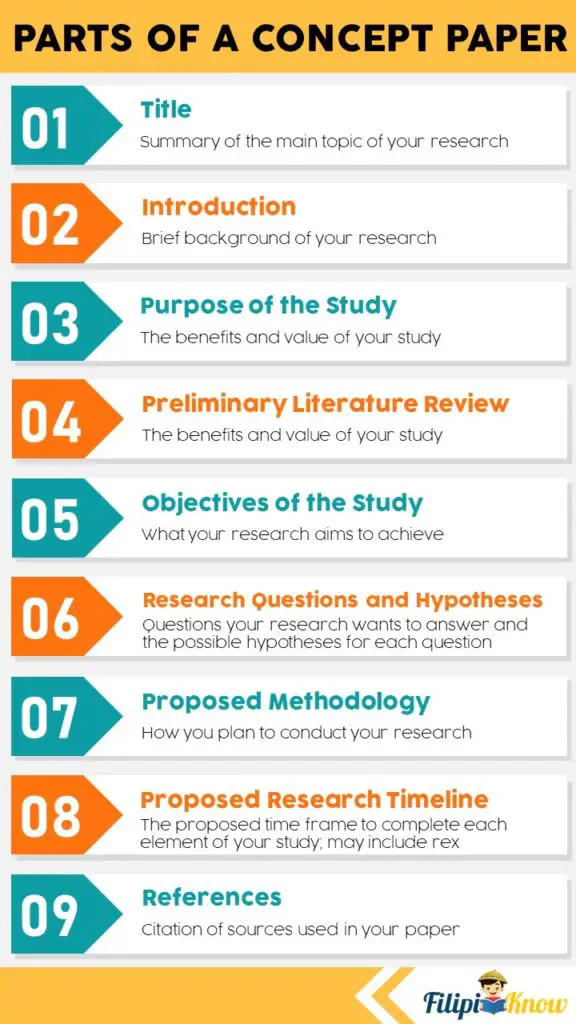
The title for your paper must be able to effectively summarize what your research is all about. Use simple words so that people who read the title of your research will know what it’s all about even without reading the entire paper.
The introduction should give the reader a brief background of the research topic and state the main objective that your project aims to achieve. This section should also include a short overview of the benefits of the research project to persuade the reader to acknowledge the need for the project.
The Purpose of the Study should be written in a way that convinces the reader of the need to address the existing problem or gap in knowledge that the research project aims to resolve. In this section, you have to go into more detail about the benefits and value of your project for the target audience/s.
This section features related studies and papers that will support your research topic. Use this section to analyze the results and methodologies of previous studies and address any gaps in knowledge or questions that your research project aims to answer. You may also use the data to assert the importance of conducting your research.
When choosing which papers and studies you should include in the Preliminary Literature Review, make sure to choose relevant and reliable sources. Reliable sources include academic journals, credible news outlets, government websites, and others. Also, take note of the authors for the papers as you will need to cite them in the References section.
Simply state the main objectives that your research is trying to achieve. The objectives should be able to indicate the direction of the study for both the reader and the researcher. As with other elements in the paper, the objectives should be specific and clearly defined.
Gather the research questions and equivalent research hypotheses you formulated in the earlier step and list them down in this section.
In this section, you should be able to guide the reader through the process of how you will conduct the research project. Make sure to state the purpose for each step of the process, as well as the type of data to be collected and the target population.
Depending on the nature of your research project, the length of the entire process can vary significantly. What’s important is that you are able to provide a reasonable and achievable timeline for your project.
Make sure the time you will allot for each component of your research won’t be too excessive or too insufficient so that the quality of your research won’t suffer.
Ensure that you will give credit to all the authors of the sources you used in your paper. Depending on your area of study or the instructions of your professor, you may need to use a certain style of citation.
There are three main citation styles: the American Psychological Association (APA), Modern Language Association (MLA), and the Chicago style.
The APA style is mostly used for papers related to education, psychology, and the sciences. The APA citation style usually follows this format:
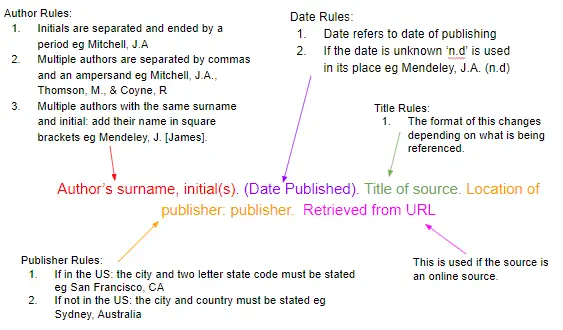
The MLA citation style is the format used by papers and manuscripts in disciplines related to the arts and humanities. The MLA citation style follows this format:
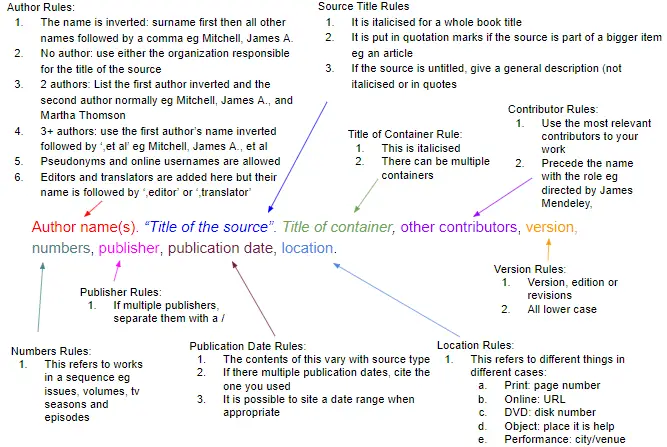
The Chicago citation style is usually used for papers related to business, history, and the fine arts. It follows this citation format:

This is a concept paper sample provided by Dr. Bernard Lango from the Jomo Kenyatta University of Agriculture and Technology (modified for use in this article). Simply click the link above the download the PDF file.
- Use simple, concise language. Minimize the use of flowery language and always try to use simple and easy-to-understand language. Too many technical or difficult words in your paper may alienate your readers and make your paper hard to read.
- Choose your sources wisely. When scouring the Internet for sources to use, you should always be wary and double-check the authenticity of your source. Doing this will increase the authenticity of your research project’s claims and ensure better data gathered during the process.
- Follow the specified format, if any. Make sure to follow any specified format when writing your concept paper. This is very important, especially if you’re writing your concept paper for class. Failure to follow the format will usually result in point deductions and delays because of multiple revisions needed.
- Proofread often. Make it a point to reread different sections of your concept paper after you write them. Another way you can do this is by taking a break for a few days and then coming back to proofread your writing. You may notice certain areas you’d like to revise or mistakes you’d like to fix. Make proofreading a habit to increase the quality of your paper.
Written by Ruth Raganit
in Career and Education , Juander How
Ruth Raganit
Ruth Raganit obtained her Bachelor of Science degree in Geology from the University of the Philippines – Diliman. Her love affair with Earth sciences began when she saw a pretty rock and wondered how it came to be. She also likes playing video games, doing digital art, and reading manga.
Browse all articles written by Ruth Raganit
Copyright Notice
All materials contained on this site are protected by the Republic of the Philippines copyright law and may not be reproduced, distributed, transmitted, displayed, published, or broadcast without the prior written permission of filipiknow.net or in the case of third party materials, the owner of that content. You may not alter or remove any trademark, copyright, or other notice from copies of the content. Be warned that we have already reported and helped terminate several websites and YouTube channels for blatantly stealing our content. If you wish to use filipiknow.net content for commercial purposes, such as for content syndication, etc., please contact us at legal(at)filipiknow(dot)net

Concept Papers in Research: Deciphering the blueprint of brilliance
Concept papers hold significant importance as a precursor to a full-fledged research proposal in academia and research. Understanding the nuances and significance of a concept paper is essential for any researcher aiming to lay a strong foundation for their investigation.
Table of Contents
What Is Concept Paper
A concept paper can be defined as a concise document which outlines the fundamental aspects of a grant proposal. It outlines the initial ideas, objectives, and theoretical framework of a proposed research project. It is usually two to three-page long overview of the proposal. However, they differ from both research proposal and original research paper in lacking a detailed plan and methodology for a specific study as in research proposal provides and exclusion of the findings and analysis of a completed research project as in an original research paper. A concept paper primarily focuses on introducing the basic idea, intended research question, and the framework that will guide the research.
Purpose of a Concept Paper
A concept paper serves as an initial document, commonly required by private organizations before a formal proposal submission. It offers a preliminary overview of a project or research’s purpose, method, and implementation. It acts as a roadmap, providing clarity and coherence in research direction. Additionally, it also acts as a tool for receiving informal input. The paper is used for internal decision-making, seeking approval from the board, and securing commitment from partners. It promotes cohesive communication and serves as a professional and respectful tool in collaboration.
These papers aid in focusing on the core objectives, theoretical underpinnings, and potential methodology of the research, enabling researchers to gain initial feedback and refine their ideas before delving into detailed research.
Key Elements of a Concept Paper
Key elements of a concept paper include the title page , background , literature review , problem statement , methodology, timeline, and references. It’s crucial for researchers seeking grants as it helps evaluators assess the relevance and feasibility of the proposed research.
Writing an effective concept paper in academic research involves understanding and incorporating essential elements:
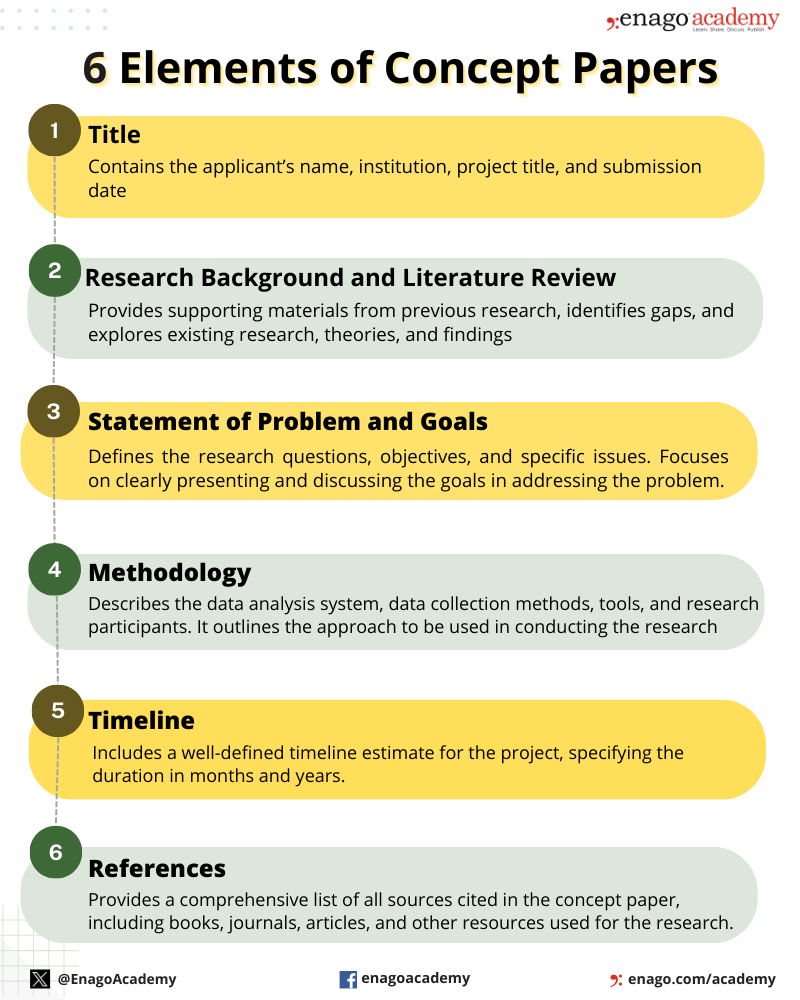
How to Write a Concept Paper?
To ensure an effective concept paper, it’s recommended to select a compelling research topic, pose numerous research questions and incorporate data and numbers to support the project’s rationale. The document must be concise (around five pages) after tailoring the content and following the formatting requirements. Additionally, infographics and scientific illustrations can enhance the document’s impact and engagement with the audience. The steps to write a concept paper are as follows:
1. Write a Crisp Title:
Choose a clear, descriptive title that encapsulates the main idea. The title should express the paper’s content. It should serve as a preview for the reader.
2. Provide a Background Information:
Give a background information about the issue or topic. Define the key terminologies or concepts. Review existing literature to identify the gaps your concept paper aims to fill.
3. Outline Contents in the Introduction:
Introduce the concept paper with a brief overview of the problem or idea you’re addressing. Explain its significance. Identify the specific knowledge gaps your research aims to address and mention any contradictory theories related to your research question.
4. Define a Mission Statement:
The mission statement follows a clear problem statement that defines the problem or concept that need to be addressed. Write a concise mission statement that engages your research purpose and explains why gaining the reader’s approval will benefit your field.
5. Explain the Research Aim and Objectives:
Explain why your research is important and the specific questions you aim to answer through your research. State the specific goals and objectives your concept intends to achieve. Provide a detailed explanation of your concept. What is it, how does it work, and what makes it unique?
6. Detail the Methodology:
Discuss the research methods you plan to use, such as surveys, experiments, case studies, interviews, and observations. Mention any ethical concerns related to your research.
7. Outline Proposed Methods and Potential Impact:
Provide detailed information on how you will conduct your research, including any specialized equipment or collaborations. Discuss the expected results or impacts of implementing the concept. Highlight the potential benefits, whether social, economic, or otherwise.
8. Mention the Feasibility
Discuss the resources necessary for the concept’s execution. Mention the expected duration of the research and specific milestones. Outline a proposed timeline for implementing the concept.
9. Include a Support Section:
Include a section that breaks down the project’s budget, explaining the overall cost and individual expenses to demonstrate how the allocated funds will be used.
10. Provide a Conclusion:
Summarize the key points and restate the importance of the concept. If necessary, include a call to action or next steps.
Although the structure and elements of a concept paper may vary depending on the specific requirements, you can tailor your document based on the guidelines or instructions you’ve been given.
Here are some tips to write a concept paper:
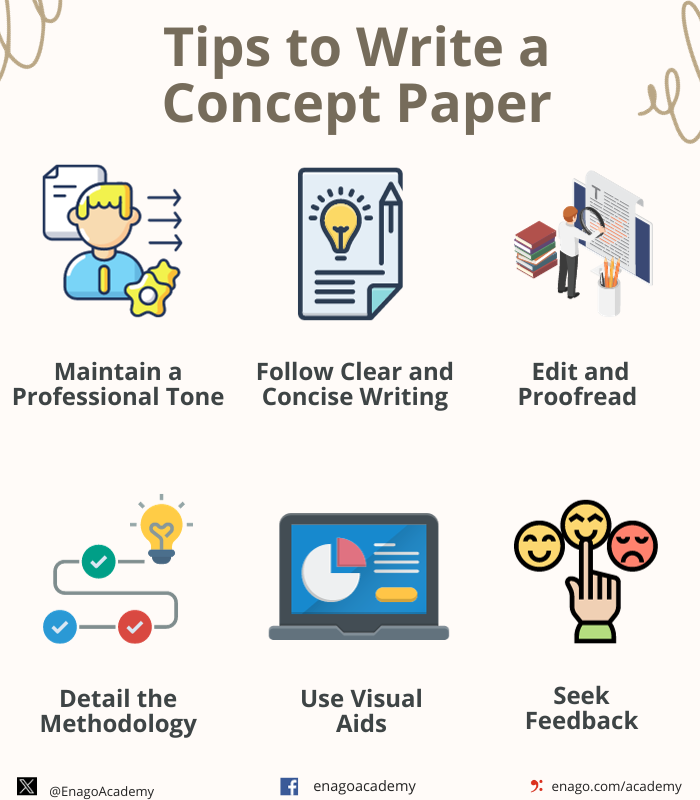
Example of a Concept Paper
Here is an example of a concept paper. Please note, this is a generalized example. Your concept paper should align with the specific requirements, guidelines, and objectives you aim to achieve in your proposal. Tailor it accordingly to the needs and context of the initiative you are proposing.
Download Now!
Importance of a Concept Paper
Concept papers serve various fields, influencing the direction and potential of research in science, social sciences, technology, and more. They contribute to the formulation of groundbreaking studies and novel ideas that can impact societal, economic, and academic spheres.
A concept paper serves several crucial purposes in various fields:
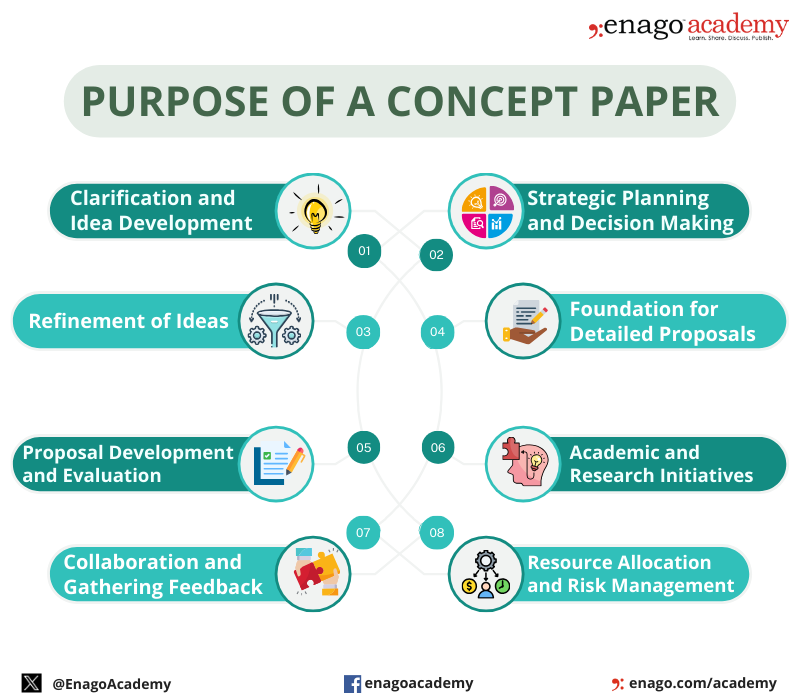
In summary, a well-crafted concept paper is essential in outlining a clear, concise, and structured framework for new ideas or proposals. It helps in assessing the feasibility, viability, and potential impact of the concept before investing significant resources into its implementation.
How well do you understand concept papers? Test your understanding now!
Fill the Details to Check Your Score

Role of AI in Writing Concept Papers
The increasing use of AI, particularly generative models, has facilitated the writing process for concept papers. Responsible use involves leveraging AI to assist in ideation, organization, and language refinement while ensuring that the originality and ethical standards of research are maintained.
AI plays a significant role in aiding the creation and development of concept papers in several ways:
1. Idea Generation and Organization
AI tools can assist in brainstorming initial ideas for concept papers based on key concepts. They can help in organizing information, creating outlines, and structuring the content effectively.
2. Summarizing Research and Data Analysis
AI-powered tools can assist in conducting comprehensive literature reviews, helping writers to gather and synthesize relevant information. AI algorithms can process and analyze vast amounts of data, providing insights and statistics to support the concept presented in the paper.
3. Language and Style Enhancement
AI grammar checker tools can help writers by offering grammar, style, and tone suggestions, ensuring professionalism. It can also facilitate translation, in case a global collaboration.
4. Collaboration and Feedback
AI platforms offer collaborative features that enable multiple authors to work simultaneously on a concept paper, allowing for real-time contributions and edits.
5. Customization and Personalization
AI algorithms can provide personalized recommendations based on the specific requirements or context of the concept paper. They can assist in tailoring the concept paper according to the target audience or specific guidelines.
6. Automation and Efficiency
AI can automate certain tasks, such as citation formatting, bibliography creation, or reference checking, saving time for the writer.
7. Analytics and Prediction
AI models can predict potential outcomes or impacts based on the information provided, helping writers anticipate the possible consequences of the proposed concept.
8. Real-Time Assistance
AI-driven chat-bots can provide real-time support and answers to specific questions related to the concept paper writing process.
AI’s role in writing concept papers significantly streamlines the writing process, enhances the quality of the content, and provides valuable assistance in various stages of development, contributing to the overall effectiveness of the final document.
Concept papers serve as the stepping stone in the research journey, aiding in the crystallization of ideas and the formulation of robust research proposals. It the cornerstone for translating ideas into impactful realities. Their significance spans diverse domains, from academia to business, enabling stakeholders to evaluate, invest, and realize the potential of groundbreaking concepts.
Frequently Asked Questions
A concept paper can be defined as a concise document outlining the fundamental aspects of a grant proposal such as the initial ideas, objectives, and theoretical framework of a proposed research project.
A good concept paper should offer a clear and comprehensive overview of the proposed research. It should demonstrate a strong understanding of the subject matter and outline a structured plan for its execution.
Concept paper is important to develop and clarify ideas, develop and evaluate proposal, inviting collaboration and collecting feedback, presenting proposals for academic and research initiatives and allocating resources.
I got wonderful idea
It helps a lot for my concept paper.
Rate this article Cancel Reply
Your email address will not be published.

Enago Academy's Most Popular Articles

- Diversity and Inclusion
Need for Diversifying Academic Curricula: Embracing missing voices and marginalized perspectives
In classrooms worldwide, a single narrative often dominates, leaving many students feeling lost. These stories,…

- Career Corner
- Trending Now
Recognizing the signs: A guide to overcoming academic burnout
As the sun set over the campus, casting long shadows through the library windows, Alex…

Reassessing the Lab Environment to Create an Equitable and Inclusive Space
The pursuit of scientific discovery has long been fueled by diverse minds and perspectives. Yet…

- AI in Academia
Simplifying the Literature Review Journey — A comparative analysis of 6 AI summarization tools
Imagine having to skim through and read mountains of research papers and books, only to…

- Reporting Research
How to Improve Lab Report Writing: Best practices to follow with and without AI-assistance
Imagine you’re a scientist who just made a ground-breaking discovery! You want to share your…

Sign-up to read more
Subscribe for free to get unrestricted access to all our resources on research writing and academic publishing including:
- 2000+ blog articles
- 50+ Webinars
- 10+ Expert podcasts
- 50+ Infographics
- 10+ Checklists
- Research Guides
We hate spam too. We promise to protect your privacy and never spam you.
I am looking for Editing/ Proofreading services for my manuscript Tentative date of next journal submission:

As a researcher, what do you consider most when choosing an image manipulation detector?

Community Blog
Keep up-to-date on postgraduate related issues with our quick reads written by students, postdocs, professors and industry leaders.
What is a Concept Paper and How do You Write One?
- By DiscoverPhDs
- August 26, 2020

What is a Concept Paper?
A concept paper is a short document written by a researcher before starting their research project, with the purpose of explaining what the study is about, why it is important and the methods that will be used.
The concept paper will include your proposed research title, a brief introduction to the subject, the aim of the study, the research questions you intend to answer, the type of data you will collect and how you will collect it. A concept paper can also be referred to as a research proposal.
What is the Purpose of a Concept Paper?
The primary aim of a research concept paper is to convince the reader that the proposed research project is worth doing. This means that the reader should first agree that the research study is novel and interesting. They should be convinced that there is a need for this research and that the research aims and questions are appropriate.
Finally, they should be satisfied that the methods for data collection proposed are feasible, are likely to work and can be performed within the specific time period allocated for this project.
The three main scenarios in which you may need to write a concept paper are if you are:
- A final year undergraduate or master’s student preparing to start a research project with a supervisor.
- A student submitting a research proposal to pursue a PhD project under the supervision of a professor.
- A principal investigator submitting a proposal to a funding body to secure financial support for a research project.
How Long is a Concept Paper?
The concept paper format is usually between 2 and 3 pages in length for students writing proposals for undergraduate, master’s or PhD projects. Concept papers written as part of funding applications may be over 20 pages in length.
How do you Write a Concept Paper?
There are 6 important aspects to consider when writing a concept paper or research proposal:
- 1. The wording of the title page, which is best presented as a question for this type of document. At this study concept stage, you can write the title a bit catchier, for example “Are 3D Printed Engine Parts Safe for Use in Aircraft?”.
- A brief introduction and review of relevant existing literature published within the subject area and identification of where the gaps in knowledge are. This last bit is particularly important as it guides you in defining the statement of the problem. The concept paper should provide a succinct summary of ‘the problem’, which is usually related to what is unknown or poorly understood about your research topic . By the end of the concept paper, the reader should be clear on how your research idea will provide a ‘solution’ to this problem.
- The overarching research aim of your proposed study and the objectives and/or questions you will address to achieve this aim. Align all of these with the problem statement; i.e. write each research question as a clear response to addressing the limitations and gaps identified from previous literature. Also give a clear description of your primary hypothesis.
- The specific data outputs that you plan to capture. For example, will this be qualitative or quantitative data? Do you plan to capture data at specific time points or at other defined intervals? Do you need to repeat data capture to asses any repeatability and reproducibility questions?
- The research methodology you will use to capture this data, including any specific measurement or analysis equipment and software you will use, and a consideration of statistical tests to help interpret the data. If your research requires the use of questionnaires, how will these be prepared and validated? In what sort of time frame would you plan to collect this data?
- Finally, include a statement of the significance of the study , explaining why your research is important and impactful. This can be in the form of a concluding paragraph that reiterate the statement of the problem, clarifies how your research will address this and explains who will benefit from your research and how.
You may need to include a short summary of the timeline for completing the research project. Defining milestones of the time points at which you intend to complete certain tasks can help to show that you’ve considered the practicalities of running this study. It also shows that what you have proposed is feasible in order to achieve your research goal.
If you’re pitching your proposed project to a funder, they may allocate a proportion of the money based on the satisfactory outcome of each milestone. These stakeholders may also be motivated by knowing that you intend to convert your dissertation into an article for journal publication; this level of dissemination is of high importance to them.
Additionally, you may be asked to provide a brief summary of the projected costs of running the study. For a PhD project this could be the bench fees associated with consumables and the cost of any travel if required.
Make sure to include references and cite all other literature and previous research that you discuss in your concept paper.
This guide gave you an overview of the key elements you need to know about when writing concept papers. The purpose of these are first to convey to the reader what your project’s purpose is and why your research topic is important; this is based on the development of a problem statement using evidence from your literature review.
Explain how it may positively impact your research field and if your proposed research design is appropriate and your planned research method achievable.

In the UK, a dissertation, usually around 20,000 words is written by undergraduate and Master’s students, whilst a thesis, around 80,000 words, is written as part of a PhD.

Considering whether to do an MBA or a PhD? If so, find out what their differences are, and more importantly, which one is better suited for you.

Learn 10 ways to impress a PhD supervisor for increasing your chances of securing a project, developing a great working relationship and more.
Join thousands of other students and stay up to date with the latest PhD programmes, funding opportunities and advice.

Browse PhDs Now

In Finland, all new PhD holders are given a traditional Doctoral Hat and Doctoral Sword during a Conferment Ceremony, symbolising the freedom of research.

The answer is simple: there is no age limit for doing a PhD; in fact, the oldest known person to have gained a PhD in the UK was 95 years old.

Jay is in the third year of his PhD at Savitribai Phule Pune University, researching the applications of mesenchymal stem cells and nanocarrier for bone tissue engineering.

Prof Mair gained her PhD in cognitive neuroscience from Bournemouth University in 2004. She is now a consultant working with the fashion industry and published her book in 2018.
Join Thousands of Students
What exactly is a Concept Paper, and how do you write one?
Learn why a concept paper is important, what the main elements of a research concept paper are, and how to create an excellent one.
Prior to submitting a formal proposal (business proposal, product, or research proposal), many private organizations have historically asked for the submission of a concept paper for review.
Recently, organizations have begun to advocate for the usage of concept papers as a way for applicants to obtain informal input on their ideas and projects before submitting a proposal. Several of these organizations now demand a concept paper as part of the official application process.
Simply described, a concept paper is a preliminary document that explains the purpose of research, why it is being conducted, and how it will be performed. It examines a concept or idea and offers an outline of the topic that a researcher wants to pursue. Continue reading to learn more about concept papers and how to create a good one.
What a concept paper is and its purpose
A concept paper is a brief paper that outlines the important components of a research or project before it is carried out. Its purpose is to offer an overview. Entrepreneurs working on a business idea or product, as well as students and researchers, frequently write concept papers .
Researchers may be required to prepare a concept paper when submitting a project proposal to a funding authority to acquire the required grants.
As a consequence, the importance is based on the fact that it should help the examiner determine whether the research is relevant, practicable, and useful .
If not, they may suggest looking into a different research area. It also allows the examiner to assess your comprehension of the research and, as a result, if you are likely to require assistance in completing the research.
Illustrate your Concept Paper with infographics
Infographics are very useful to explain complex subjects in a very short time. Use Mind the Graph to create beautiful infographics for your Concept Paper with scientifically accurate illustrations, icons, arrows and many other design tools.
Concept paper’s elements for an academic research
To produce an effective concept paper, you must first comprehend the essential elements of academic research:
- Title page: Mention the applicant’s name, institution, project title, and submission date.
- Background for the research: The second section should be the purpose section, which should be able to clear out what has already been stated about the subject, any gaps in information that need to be filled or problems to be solved, as well as the reason why you wish to examine the issue.
- Literature review: In this section, you should provide a theoretical basis and supporting material for your chosen subject.
- State the problem and your goals: Describe the overall problems, including the research questions and objectives. State your research’s unique and original aspects, concentrate on providing and clearly discussing your goals towards the problem.
- Methodology: Provide the data analysis system to be utilized, data collecting method, tools to be used, and research participants in this section.
- Timeline: Include a realistic timeline estimate that is defined in months and years.
- References: Add a list of all sources cited in your concept paper , such as books, journals, and other resources.
Tips on writing an effective concept paper
A concept paper is extremely crucial for a project or research, especially if it requires funding. Check out these simple tips to ensure your concept paper is successful and simple.
- Choose a research topic that truly piques your curiosity
- Create a list of research questions. The more, the merrier.
- When describing the project’s reasoning, use data and numbers.
- Use no more than 5 single-spaced pages.
- Tailor your speech to the appropriate audience.
- Make certain that the basic format elements, such as page numbers, are included.
- Spend additional time on your timeline as this section is critical for funding.
- Give specific examples of how you plan to measure your progress toward your goals.
- Provide an initial budget when seeking funds. Sponsors will want to obtain an idea of how much funds are required.
Start creating infographics and scientific illustrations
Use the power of infographics and scientific illustrations to your advantage. Including graphic assets in your work may increase your authority and highlight all of the most valuable information, ensuring that your audience is engaged and completely comprehensive of the information you are providing.


Subscribe to our newsletter
Exclusive high quality content about effective visual communication in science.
Unlock Your Creativity
Create infographics, presentations and other scientifically-accurate designs without hassle — absolutely free for 7 days!
About Jessica Abbadia
Jessica Abbadia is a lawyer that has been working in Digital Marketing since 2020, improving organic performance for apps and websites in various regions through ASO and SEO. Currently developing scientific and intellectual knowledge for the community's benefit. Jessica is an animal rights activist who enjoys reading and drinking strong coffee.
Content tags
We use cookies on this site to enhance your experience
By clicking any link on this page you are giving your consent for us to set cookies.
A link to reset your password has been sent to your email.
Back to login
We need additional information from you. Please complete your profile first before placing your order.
Thank you. payment completed., you will receive an email from us to confirm your registration, please click the link in the email to activate your account., there was error during payment, orcid profile found in public registry, download history, understanding and developing a concept paper.
- Charlesworth Author Services
- 15 December, 2021
A concept paper, simply put, is a one- to two-page written document describing an idea for a project . At this stage, there is no need to flesh out details, but rather just introduce the overall rationale of the project, how it’ll be carried out and the expected outcomes. There is no hard rule as to how this should be structured, but below are some tips on what to include and why to include them.
Discuss the rationale
The need for the project is an important aspect to address, and is often something a funding body might look for when considering funding a project. A concept paper might be the first thing a funding round requests to get an idea of what the project is all about. So make sure that it includes:
- Importance of the work being proposed
- What the impact (not the same as ‘ impact factor ’ – see later below) will be
- How the outcomes of your project might meet or respond to the need
- Priorities of your intended audience
Outline your methodology and procedures
Your overall methodology , i.e. how you intend to approach your work, should be outlined here to give your reader an idea of how you propose to achieve your research objectives. Mentioning the proposed methodology in advance allows them to conduct an independent evaluation into whether it is a valid approach.
Further, you should highlight some exciting, specific procedures or methods that you might be especially well-placed to perform. For example, your institute may have a specific piece of equipment, or you may have access to very high quality expertise. This will inspire confidence in the review panel that you are well-positioned to take the project on.
Describe the potential impact
Impact is a term often thrown around in research circles, usually relating to the ‘impact factor’ of a journal. Impact in this instance does not refer to that. The impact that you should be describing here is the real-world impact of your work.
Will your idea or innovation change people’s lives? Will it save the taxpayer money? How will it do those things?
Make sure you describe impacts that go beyond discovering something new to shaking up your research community.
A concept paper is a loose framework by which you are able to quickly communicate an idea for a piece of work you might want to do in the future. At the very least, it can help you put ideas to paper and look at them as a whole, allowing you to critically assess what is needed to make it a reality. In the best case scenario, a concept paper might be used to advance your grant applications or attract investment for your idea. Whatever you are using it for, it is a valuable piece of writing that can help you formalise your idea and make it a reality.
Read next (second) in series: Writing a successful Research Proposal
Maximise your publication success with Charlesworth Author Services.
Charlesworth Author Services, a trusted brand supporting the world’s leading academic publishers, institutions and authors since 1928.
To know more about our services, visit: Our Services
Share with your colleagues
Related resources.

Writing a successful Research Proposal
Charlesworth Author Services 08/03/2022 00:00:00

Concept Paper vs. Research Proposal – and when to use each

Preparing and writing your PhD Research Proposal
Charlesworth Author Services 02/08/2021 00:00:00
Related webinars

Bitesize Webinar: Writing Competitive Grant Proposals: Module 1- Unpacking the Request for Proposals
Charlesworth Author Services 09/03/2021 00:00:00

Bitesize Webinar: Writing Competitive Grant Proposals: Module 2- Choosing the Right Funder

Bitesize Webinar: Writing Competitive Grant Proposals: Module 3- Structuring the Proposal

Bitesize Webinar: Writing Competitive Grant Proposals: Module 4- Developing a Grant Budget

How to write the Rationale for your research
Charlesworth Author Services 19/11/2021 00:00:00

A guide to finding the right Funding Agency for your project
Charlesworth Author Services 27/01/2021 00:00:00

Difference between Methodology and Method
Charlesworth Author Services 15/12/2021 00:00:00
Academia.edu no longer supports Internet Explorer.
To browse Academia.edu and the wider internet faster and more securely, please take a few seconds to upgrade your browser .
Enter the email address you signed up with and we'll email you a reset link.
- We're Hiring!
- Help Center

How to write a simple academic project concept paper with practical sample by Dr Lango

2019, Lango
A concept paper enables in putting thoughts and ideas into paper for consideration for research. It is from the concept paper that one develops the research proposal which can either be business or academic oriented. Most students, and especially the postgraduate students who have a mandatory requirement of undertaking research, usually goes direct to the research proposal. Some quotas also have professed the school of thought that a concept paper and research proposal are the same. As good as they may seem similar, they are different in the process and presentation. The concept paper aim is to capture the thoughts and ideas while the research proposal captures the ideas in a structured manner for approval to research. Therefore, in order to write a simple concept paper, follow these steps:
Related Papers
Crystal Machiavelli
Olga Sasinovskaya
peter achoki
Melody McLaren
China-USA Business Review ISSN 1537-1514 Chinese Business Review ISSN 1537-1506 , Michela Pellicelli , Tahereh Jahani
Salicious Crumb
Fernando Perini
Arabella Bhutto
Quaternary Science Reviews
Rhawn Denniston
RELATED PAPERS
Studia Geologica Salmanticensia
Santiago Martin De Jesus
Baltic Journal of Economic Studies
Iryna Kalenyuk
Interdisciplinary Environmental Review
Bulgarian Journal of Agricultural Science
Damir Jezek
Glaucia Xavier
gonzalo simarro
JURNAL ILMIAH PETERNAKAN TERPADU
Dian Safwati
SSRN Electronic Journal
Daipayan Mandal
alex sachonyi
ANZ Journal of Surgery
Robert Bolton
Journal of Indian Society of Periodontology
Swapna Mahale
Alessandro Marcelletti
Oral Radiology
Sahar Samir
Dermatology
Jean-marie Lachapelle
Revue internationale de politique comparée
Daniel-Louis Seiler
Jiaolong Zeng
Journal of Bone and Joint Diseases
Ziaul hoda shaan
Journal of Hydraulic Research
Soumendra N Kuiry
Gestão & produção
Horacio Yanasse
Irma Cantu H
Charles Zartman
The International Archives of the Photogrammetry, Remote Sensing and Spatial Information Sciences
Farshad Hakimpour
Ukrainian Food Journal
Agota Giedre Raisiene
RELATED TOPICS
- We're Hiring!
- Help Center
- Find new research papers in:
- Health Sciences
- Earth Sciences
- Cognitive Science
- Mathematics
- Computer Science
- Academia ©2024
Purdue Online Writing Lab Purdue OWL® College of Liberal Arts
Welcome to the Purdue Online Writing Lab

Welcome to the Purdue OWL
This page is brought to you by the OWL at Purdue University. When printing this page, you must include the entire legal notice.
Copyright ©1995-2018 by The Writing Lab & The OWL at Purdue and Purdue University. All rights reserved. This material may not be published, reproduced, broadcast, rewritten, or redistributed without permission. Use of this site constitutes acceptance of our terms and conditions of fair use.
The Online Writing Lab at Purdue University houses writing resources and instructional material, and we provide these as a free service of the Writing Lab at Purdue. Students, members of the community, and users worldwide will find information to assist with many writing projects. Teachers and trainers may use this material for in-class and out-of-class instruction.
The Purdue On-Campus Writing Lab and Purdue Online Writing Lab assist clients in their development as writers—no matter what their skill level—with on-campus consultations, online participation, and community engagement. The Purdue Writing Lab serves the Purdue, West Lafayette, campus and coordinates with local literacy initiatives. The Purdue OWL offers global support through online reference materials and services.
A Message From the Assistant Director of Content Development
The Purdue OWL® is committed to supporting students, instructors, and writers by offering a wide range of resources that are developed and revised with them in mind. To do this, the OWL team is always exploring possibilties for a better design, allowing accessibility and user experience to guide our process. As the OWL undergoes some changes, we welcome your feedback and suggestions by email at any time.
Please don't hesitate to contact us via our contact page if you have any questions or comments.
All the best,
Social Media
Facebook twitter.
Supply chain socially sustainability practices and their impact on supply chain performance: a study from the Indian automobile industry
- Original Research
- Published: 29 April 2024
Cite this article

- Satyendra Kumar Sharma 1 ,
- Sajeev Abraham George 2 ,
- Praveen Ranjan Srivastava ORCID: orcid.org/0000-0001-7467-5500 3 ,
- Fauzia Jabeen 4 &
- Cisem Lafci 5
165 Accesses
Explore all metrics
While sustainability has been a well-researched area in academic literature, the performance impact of its social dimensions remains largely unexplored, especially in the context of emerging economies. The aim of this research paper is to test and validate the dimensions of supply chain social sustainability (SCSS) that firms should focus on and to examine the relationships between these practices and supply chain performance, both short term and long term. This paper adopts a questionnaire-based survey research approach in the context of Indian automobile industry. Empirical validation of the conceptual model developed was carried out using Confirmatory Factor Analysis. Multiple regression was used to test the relationships between SCSS practices and supply chain performance. This study finds empirical support to the proposition that a firm’s initiatives on SCSS dimensions of safety, labour rights, ethical practices and welfare initiatives for people and their communities provide performance benefits to them and to their partners in the supply chains. Regression analysis revealed that safety (0.339) and labour rights (0.601) contribute to both short term and long term performance for the supply chain. While ethical practices have a positive impact on short term performance, welfare initiatives only provide long term qualitative benefits. SCSS is in evolving concept and adopting the right mix of factors can help firms to achieve sustainability in all three dimensions of the triple-bottom-line framework (People, Planet and Profit).
This is a preview of subscription content, log in via an institution to check access.
Access this article
Price includes VAT (Russian Federation)
Instant access to the full article PDF.
Rent this article via DeepDyve
Institutional subscriptions
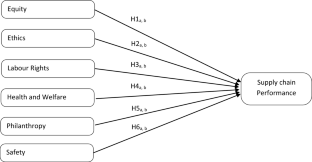
Similar content being viewed by others

Supply chain disruptions and resilience: a major review and future research agenda

Sustainability trends and gaps in the textile, apparel and fashion industries

Environmental-, social-, and governance-related factors for business investment and sustainability: a scientometric review of global trends
Agami, N., Saleh, M., & Rasmy, M. (2012). A Hybrid Dynamic Framework for Supply Chain performance improvement. IEEE Systems Journal, 6 (3), 469–478.
Article Google Scholar
Ahen, F., & Amankwah-Amoah, J. (2018). Institutional voids and the philanthropization of CSR practices: Insights from developing economies. Sustainability, 10 (7), 2400.
Ahmadi, H. B., Kusi-Sarpong, S., & Rezaei, J. (2017). Assessing the social sustainability of supply chains using Best Worst Method Resources. Conservation and Recycling, 126 , 99–106.
Amaeshi, K., Adegbite, E., Ogbechie, C., Idemudia, U., Kan, K. A. S., Issa, M., & Anakwue, O. I. (2016). Corporate social responsibility in SMEs: A shift from philanthropy to institutional works? Journal of Business Ethics, 138 , 385–400.
Andersen, M., & Skjoett-Larsen, T. (2009). Corporate social responsibility in global supply chains. Supply Chain Management: An International Journal, 14 (2), 75–86.
Arzu Akyuz, G., & Erman Erkan, T. (2010). “ Supply chain performance measurement: A literature review. International Journal of Production Research, 48 (17), 5137–5155.
Ashby, A., Leat, M., & Hudson-Smith, M. (2012). Making connections: A review of supply chain management and sustainability literature. Supply Chain Management: An International Journal, 17 (5), 497–516.
Bai, C., Dallasega, P., Orzes, G., & Sarkis, J. (2020). Industry 4.0 technologies assessment: A sustainability perspective. International Journal of Production Economics, 229 , 107776. https://doi.org/10.1016/j.ijpe.2020.107776
Ballet, J., Bazin, D., & Mahieu, F. R. (2020). A policy framework for social sustainability: Social cohesion, equity and safety. Sustainable Development, 28 (5), 1388–1394.
Barrientos, S. (2008). Contract labor: The “‘Achilles heel’ of corporate codes in commercial value chains.” Development and Change, 39 (6), 977–990.
Beamon, B. M. (1999). Measuring supply chain performance. International Journal of Operations & Production Management, 19 (3), 275–292.
Carter, C. R. (2000). Ethical issues in international buyer–supplier relationships: A dyadic examination. Journal of Operations Management, 18 (2), 191–208.
Carter, C. R., & Jennings, M. M. (2004). The role of purchasing in corporate social responsibility: Structural equation analysis. Journal of Business Logistics., 25 (1), 145–186.
Carter, C. R., & Liane Easton, P. (2011). Sustainable supply chain management: Evolution and future directions. International Journal of Physical Distribution & Logistics Management, 41 (1), 46–62.
Carter, C. R., & Rogers, D. S. (2008). A framework of sustainable supply chain management: Moving toward new theory. International Journal of Physical Distribution & Logistics Management, 38 (5), 360–387.
Chan, F. T. (2003). Performance measurement in a supply chain. The International Journal of Advanced Manufacturing Technology, 21 , 534–548.
Chardine-Baumann, E., & Botta-Genoulaz, V. (2014). “A framework for sustainable performance assessment of supply chain management practices. Computers & Industrial Engineering, 76 , 138–147.
Chin, T. A., & Tat, H. H. (2015). Does gender diversity moderate the relationship between supply? chain management practice and performance in the electronic manufacturing services industry? International Journal of Logistics Research & Applications, 18 (1), 35–45.
Ciliberti, F. (2011). CSR codes and the principal-agent problem in supply chains: Four case studies. Journal of Cleaner Production, 19 (8), 885–894.
Ciliberti, F., Pontrandolfo, P., & Scozzi, B. (2008). Investigating corporate social responsibility in supply chains: A SME perspective. Journal of Cleaner Production, 16 (15), 1579–1588.
Closs, D. J., Speier, C., & Meacham, N. (2011). Sustainability to support end-to-end value chains: The role of supply chain management. Journal of the Academy of Marketing Science, 39 (1), 101–116. https://doi.org/10.1007/s11747-010-0207-4
Croom, S., Vidal, N., Spetic, W., Marshall, D., & McCarthy, L. (2018). Impact of social sustainability orientation and supply chain practices on operational performance. International Journal of Operations & Production Management, 38 (12), 2344–2366.
Dyllick, T., & Hockerts, K. (2002). Beyond the business case for corporate sustainability. Business Strategy and the Environment, 11 (2), 130–141.
Eizenberg, E., & Jabareen, Y. (2017). Social sustainability: A new conceptual framework. Sustainability, 9 (1), 68.
Elkington, J. (1998). Partnerships from cannibals with forks: The triple bottom line of 21st century business. Environmental Quality Management, 8 (1), 37–51.
Fornell, C., & Larcker, D. F. (1981). Evaluating structural equation models with unobservable variables and measurement error. Journal of Marketing Research, 18 (1), 39–50.
Golini, R., & Gualandris, J. (2018). An empirical examination of the relationship between globalisation, integration and sustainable innovation within manufacturing networks. International Journal of Operations & Production Management, Vo., 38 (3), 874–894.
Govindan, K., Shaw, M., & Majumdar, A. (2021). Social sustainability tensions in multi-tier supply chain: A systematic literature review towards conceptual framework development. Journal of Cleaner Production, 279 , 123075. https://doi.org/10.1016/j.jclepro.2020.123075
Gunasekaran, A., Patel, C., & McGaughey, R. E. (2004). A framework for supply chain performance measurement. International Journal of Production Economics, 87 (3), 333–347.
Hall, J., Matos, S., & Silvestre, B. (2012). Understanding why firms should invest in sustainable supply chains: A complexity approach. International Journal of Production Research, 50 (5), 1332–1348.
Huq, F. A., Stevenson, M., & Zorzini, M. (2014). Social sustainability in developing country suppliers: An exploratory study in the ready-made garments industry of Bangladesh. International Journal of Operations & Production Management, 34 (5), 610–638.
Hutchins, M. J., & Sutherland, J. W. (2008). An exploration of measures of social sustainability and their application to supply chain decisions. Journal of Cleaner Production, Vo., 16 (15), 1688–1698.
Kazançoglu, Y., Ozturkoglu, Y., Mangla, S. K., Ozbiltekin-Pala, M., & Ishizaka, A. (2022). A proposed framework for multi-tier supplier performance in sustainable supply chains. International Journal of Production Research, 61 (14), 1–23.
Google Scholar
Khan, S. A., Agyemang, M., Ishizaka, A., Zaman, S. I., Ali, S. M., & Laval, J. (2021). Barriers and overcoming strategies to multi-tier sustainable supply chain management: An explorative study in an emerging economy. International Journal of Sustainable Engineering, 14 (6), 1484–1495.
Klassen, R. D., & Vereecke, A. (2012). Social issues in supply chains: Capabilities link responsibility, risk (opportunity), and performance. International Journal of Production Economics, 140 (1), 103–115.
Krause, D. R., Vachon, S., & Klassen, R. D. (2009). Special topic forum on sustainable supply chain management: Introduction and reflections on the role of purchasing management. Journal of Supply Chain Management, 45 (4), 18–25.
Kumar, A., Mangla, S. K., Luthra, S., & Ishizaka, A. (2019). Evaluating the human resource related soft dimensions in green supply chain management implementation. Production Planning & Control, 30 (9), 699–715.
Lima-junior, F. R., Cesar, L., & Carpinetti, R. (2017). Computers & industrial engineering quantitative models for supply chain performance evaluation : A literature review. Computers & Industrial Engineering, 113 (July), 333–346. https://doi.org/10.1016/j.cie.2017.09.022
Ling, L., Qin, S., & Chen, X. (2011). Ensuring supply chain quality performance through applying the SCOR model. International Journal of Production Research, 49 (1), 33–57.
Lund-Thomsen, P., & Lindgreen, A. (2014). Corporate social responsibility in global value chains: Where are we now and where are we going? Journal of Business Ethics, 123 (1), 11–22.
Lund-Thomsen, P., Nadvi, K., Chan, A., Khara, N., & Xue, H. (2012). Labour in global value chains: Work conditions in football manufacturing in China, India and Pakistan. Development and Change, 43 (6), 1211–1237. https://doi.org/10.1111/j.1467-7660.2012.01798.x
Mangla, S. K., Kusi-Sarpong, S., Luthra, S., Bai, C., Jakhar, S. K., & Khan, S. A. (2020). Operational excellence for improving sustainable supply chain performance. Resources, Conservation, and Recycling, 162 , 105025.
Mani, V., Agrawal, R., Gunasekaran, A., Papadopoulos, T., Dubey, R., & Childe, S. (2016a). Social sustainability in the supply chain: construct development and measurement validation. Ecological Indicators, 71 , 270–279.
Mani, V., Agrawal, R., & Sharma, V. (2015). Social sustainability practices in the supply chain of Indian manufacturing industries. International Journal of Automation and Logistics, 1 (3), 211–233.
Mani, V., Agrawal, R., Sharma, V., & Kavitha, T. N. (2016c). Socially sustainable business practices in Indian manufacturing industries: A study of two companies. International Journal of Logistics Systems and Management, 24 (1), 18–44. https://doi.org/10.1504/IJLSM.2016.075661
Mani, V., Gunasekaran, A., & Delgado, C. (2018). Enhancing supply chain performance through supplier social sustainability: an emerging economy perspective. International Journal of Production Economics, 195 , 259–272.
Mani, V., Gunasekaran, A., Papadopoulos, T., Dubey, R., & Benjamin, H. (2016b). Supply Chain social sustainability for developing nations: Evidence from India. Resources, Conservation & Recycling, 111 , 42–44.
Mani, V., Jabbour, C. J. C., & Mani, K. T. (2020). Supply chain social sustainability in small and medium manufacturing enterprises and firms’ performance: Empirical evidence from an emerging Asian economy. International Journal of Production Economics, 227 , 107656. https://doi.org/10.1016/j.ijpe.2020.107656
Melnyk, B. M., Fineout-Overholt, E., Gallagher-Ford, L., & Kaplan, L. (2012). The state of evidence-based practice in US nurses: Critical implications for nurse leaders and educators. Journal of Nursing Administration, 42 (9), 410–417. https://doi.org/10.1097/NNA.0b013e3182664e0a
Mena, S., Leede, M. D., Baumann, D., Black, N., Lindeman, S., & McShane, L. (2010). Advancing the business and human rights agenda: Dialogue, empowerment, and constructive engagement. Journal of Business Ethics, 93 (1), 161–188.
Meseguer-Sánchez, V., Gálvez-Sánchez, F. J., López-Martínez, G., & Molina-Moreno, V. (2021). Corporate social responsibility and sustainability. A bibliometric analysis of their interrelations. Sustainability, 13 (4), 1–18. https://doi.org/10.3390/su13041636
Miles, M. P., & Munilla, L. S. (2004). The potential impact of social accountability certification on marketing: A short note. Journal of Business Ethics, 50 (1), 1–11.
Moktadir, M. A., Ali, S. M., Rajesh, R., & Paul, S. K. (2018). Modeling the interrelationships among barriers to sustainable supply chain management in leather industry. Journal of Cleaner Production, 181 , 631–651.
Morais, D. O., & Silvestre, B. S. (2018). Advancing social sustainability in supply chain management: Lessons from multiple case studies in an emerging economy. Journal of Cleaner Production, 199 , 222–235.
Nakamba, C. C., Chan, P. W., & Sharmina, M. (2017). How does social sustainability feature in studies of supply chain management? A review and research agenda. Supply Chain Management: An International Journal, 22 (6), 522–541.
Naz, F., Bögenhold, D. (2020). Transformation of Labour Market and Gender Patterns of Work. In: Unheard Voices. Palgrave Macmillan, Cham. https://doi.org/10.1007/978-3-030-54363-1_2
Pagell, M., & Gobeli, D. (2009). How plant managers’ experiences and attitudes toward sustainability relates to operational performance. Production & Operations Management, 18 (3), 278–299.
Pagell, M., Wu, Z., & Wasserman, M. E. (2010). Thinking differently about purchasing portfolios: An assessment of sustainable sourcing. Journal of Supply Chain Management, 46 (1), 57–73.
Popovic, T., Barbosa-Póvoa, A., Kraslawski, A., & Carvalho, A. (2018). Quantitative Indicators or social sustainability assessment of supply chains. Journal of Cleaner Production, 180 , 748–768.
Preuss, L., & Brown, D. (2012). Business policies on human rights: An analysis of their content and prevalence among FTSE 100 firms. Journal of Business Ethics, 109 (3), 289–299.
Rabl, T., & Kühlmann, T. M. (2008). Understanding corruption in organisations development and empirical assessment of an action model. Journal of Business Ethics, 82 (2), 477–495.
Rajak, S., & Vinodh, S. (2015). Application of fuzzy logic for social sustainability performance evaluation: A case study of an Indian automotive component manufacturing organization. Journal of Cleaner Production, 108 , 1184–1192.
Rose-Ackerman, S., & Palifka, B. J. (2016). Corruption and Government: Causes, Consequences, and Reform . Cambridge University Press.
Book Google Scholar
Ross, S. M., & Kapitan, S. (2018). Balancing self/collective-interest: Equity theory for prosocial consumption. European Journal of Marketing, 52 (3/4), 528–549.
Sancha, C., Gimenez, C., & Sierra, V. (2016). Achieving a socially responsible supply chain through assessment and collaboration. Journal of Cleaner Production, 112 , 1934–1947.
Seuring, S., & Müller, M. (2008). From a literature review to a conceptual framework for sustainable supply chain management. Journal of Cleaner Production, 16 (15), 1699–1710.
Shepherd, C., & Günter, H. (2010). Measuring Supply Chain Performance: Current Researchand Future Directions. In J. Fransoo, T. Waefler, & J. Wilson (Eds.), Behavioral Operations in Planning and Scheduling. Springer.
Silvestre, B. S. (2016). Sustainable supply chain management: Current debate and future directions. Gestão & Produção, 23 (2), 235–249.
Silvestre, B. S., Monteiro, M. S., Viana, F. L. E., & de Sousa-Filho, J. M. (2018). Challenges for sustainable supply chain management: When stakeholder collaboration becomes conducive to corruption. Journal of Cleaner Production, 194 , 766–776.
Smid, S. C., & Rosseel, Y. (2020). SEM with small samples: Two-step modeling and factor score regression versus Bayesian estimation with informative priors. In Small sample size solutions (pp. 239–254). Routledge
Sodhi, M. S., & Tang, C. S. (2018). Corporate social sustainability in supply chains: A thematic analysis of the literature. International Journal of Production Research, 56 (1–2), 882–901.
Torugsa, N. A., O’Donohue, W., & Hecker, R. (2013). Proactive CSR: an empirical analysis of the role of its economic, social and environmental dimensions on the association between capabilities and performance. Journal of Business Ethics, 115 , 383–402.
Tsolakis, N., Niedenzu, D., Simonetto, M., Dora, M., & Kumar, M. (2021). Supply network design to address United Nations Sustainable Development Goals: A case study of blockchain implementation in Thai fish industry. Journal of Business Research, 131 , 495–519.
Varsei, M., Soosay, C., Fahimnia, B., & Sarkis, J. (2014). Framing sustainability performance of supply chains with multidimensional indicators. Supply Chain Management: An International Journal, 19 (3), 242–257.
Winter, M., & Knemeyer, A. M. (2013). Exploring the integration of sustainability and supply chain management: Current state and opportunities for future inquiry. International Journal of Physical Distribution & Logistics Management, 43 (1), 18–38.
Wood, D. J. (1991). Corporate social performance revisited. Academy of Management Review, 16 (4), 691–718.
Yakovleva, N., Sarkis, J., & Sloan, T. (2012). Sustainable benchmarking of supply chains: The case of the food industry. International Journal of Production Research, 50 (5), 1297–1317.
Yawar, S. A., & Seuring, S. (2017). Management of social issues in supply chains: A literature review exploring social issues, actions and performance outcomes. Journal of Business Ethics, 141 (3), 621–643.
Zhou, M., Govindan, K., & Xie, X. (2020). How fairness perceptions, embeddedness, and knowledge sharing drive green innovation in sustainable supply chains: An equity theory and network perspective to achieve sustainable development goals. Journal of Cleaner Production, 260 , 120950.
Download references
Author information
Authors and affiliations.
Birla Institute of Technology and Science, Pilani, Pilani campus, Rajasthan, India
Satyendra Kumar Sharma
SP Jain Institute of Management & Research, Mumbai, India
Sajeev Abraham George
IIM Rohtak: Indian Institute of Management Rohtak, Rohtak, Haryana, India
Praveen Ranjan Srivastava
College of Business at Abu Dhabi University, Abu Dhabi, United Arab Emirates
Fauzia Jabeen
International Logistics Management Department, Yasar University, Izmir, Turkey
Cisem Lafci
You can also search for this author in PubMed Google Scholar
Corresponding author
Correspondence to Praveen Ranjan Srivastava .
Additional information
Publisher's note.
Springer Nature remains neutral with regard to jurisdictional claims in published maps and institutional affiliations.
Rights and permissions
Springer Nature or its licensor (e.g. a society or other partner) holds exclusive rights to this article under a publishing agreement with the author(s) or other rightsholder(s); author self-archiving of the accepted manuscript version of this article is solely governed by the terms of such publishing agreement and applicable law.
Reprints and permissions
About this article
Sharma, S.K., George, S.A., Srivastava, P.R. et al. Supply chain socially sustainability practices and their impact on supply chain performance: a study from the Indian automobile industry. Ann Oper Res (2024). https://doi.org/10.1007/s10479-024-05991-w
Download citation
Received : 12 May 2022
Accepted : 08 April 2024
Published : 29 April 2024
DOI : https://doi.org/10.1007/s10479-024-05991-w
Share this article
Anyone you share the following link with will be able to read this content:
Sorry, a shareable link is not currently available for this article.
Provided by the Springer Nature SharedIt content-sharing initiative
- Social sustainability
- Supply chains
- Confirmatory factor analysis
- Supply chain performance
- Find a journal
- Publish with us
- Track your research
Get science-backed answers as you write with Paperpal's Research feature
How Paperpal is Enhancing Academic Productivity and Accelerating Research in China
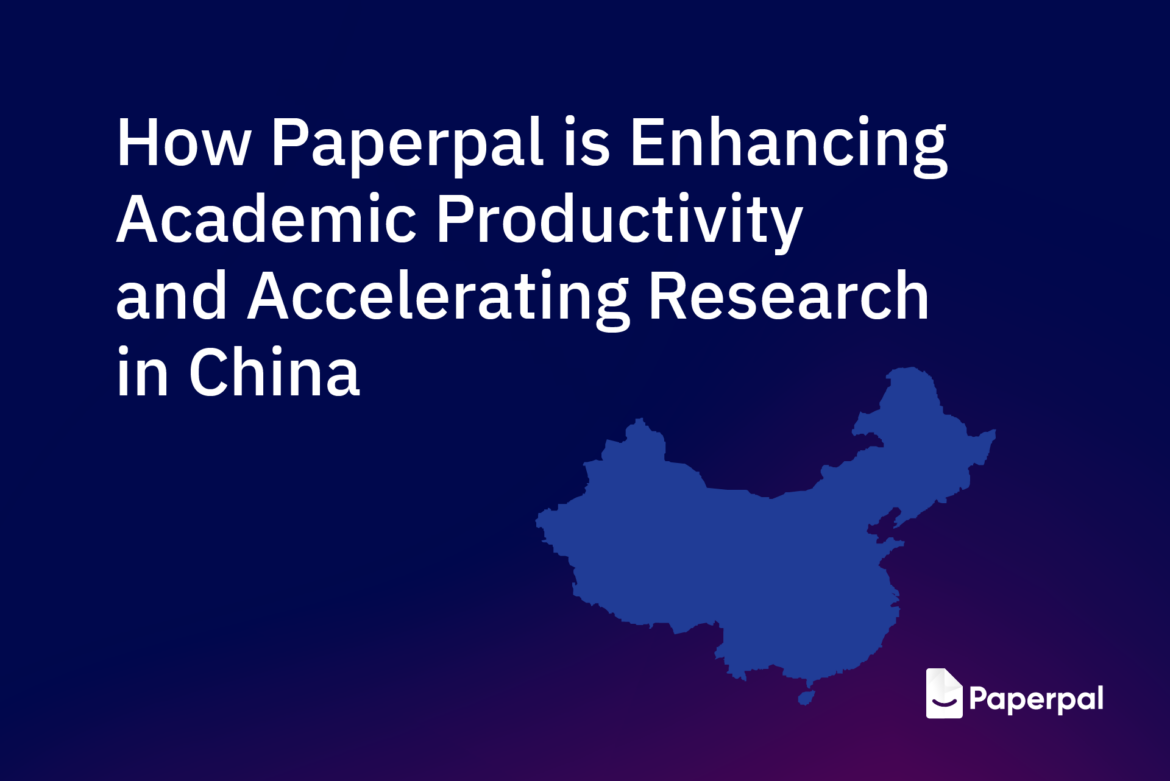
Paperpal , by Editage, has emerged as a trusted AI academic writing assistant for more than 800,000 authors worldwide, supporting them from the ideation stage all the way to submission readiness for journals. It blends over 21 years of STM experience with cutting-edge AI technology to provide comprehensive writing, language editing, and submission readiness support that boosts their chances of successful publication.
Students and researchers from China’s top universities, government organizations, and research institutions are using Paperpal to enhance their writing and submit their work for publication in leading academic publications. In this case study, we delve into how Paperpal is transforming the writing process for academics in China, ensuring high-quality writing, saving hours of time for research, and enhancing their overall productivity .
Table of Contents
- Challenges in Writing for Academics in China
- Enter Paperpal: Your One Stop for Excellence in Academic Writing
- Growth in Number of Paperpal Users in China
- Hours of Time Saved to Increase Productivity
- Adoption by Students at Top Institutions in China
- Powering Research Excellence and Innovation
- Winning the Trust of Chinese Researchers
Challenges in Writing for Academics in China
Academic writing comes with its unique set of challenges, particularly for non-native English speaking researchers. A PLOS survey showed that as compared to native English speakers, those with low English proficiency take as much as 91% more time to read English language papers and 51% more time to write a paper in English. 1 This was supported by another study on English academic writing in China, which revealed that while Chinese academics were often clear on what and how to write, almost half of them wrote in Chinese first and then translated it into English. 2
Chinese researchers also find it difficult to access efficient proofreading and accurate translation support. They typically wait for busy peers and seniors for help in reviewing their work or are forced to rely on professional services that cost them time and money. These time-consuming and often expensive processes may cause delays in research publication and reduced academic productivity. While there are many AI tools available today, very few are tailored to understand and enhance the academic writing process in particular. This is where Paperpal emerges as a reliable writing partner for Chinese researchers. With its comprehensive feature suite that provides human precision at machine speed, it helps Chinese academics write confidently and deliver high-quality English writing.
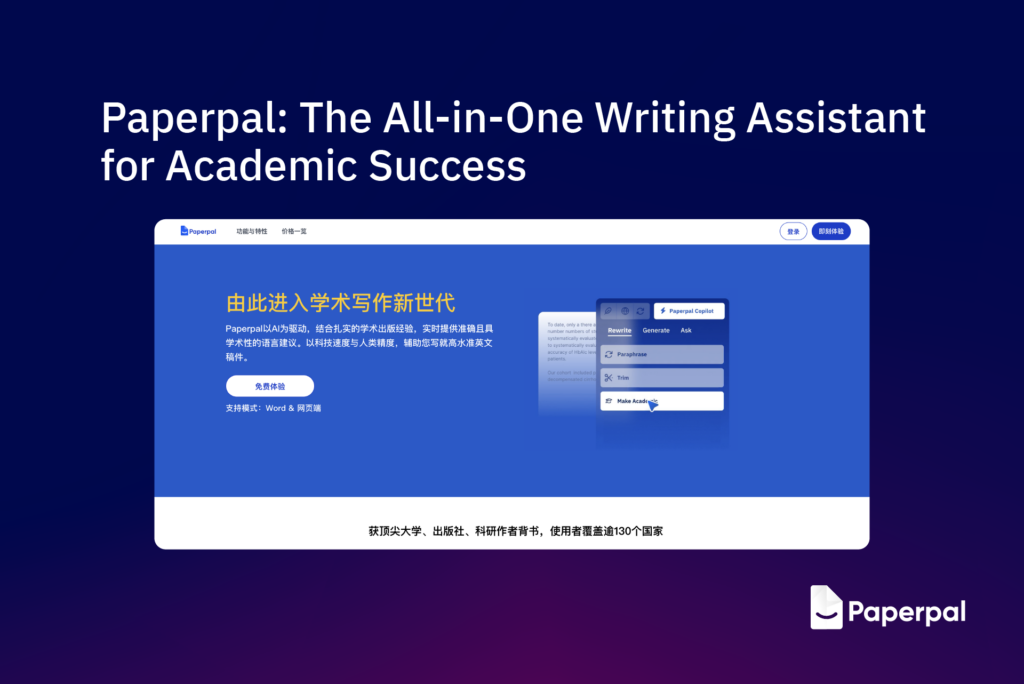
Enter Paperpal: Your One Stop for Excellence in Academic Writing
Paperpal , the all-in-one AI academic writing assistant, has been used and loved by more than 13,800 students, professors, and medical professionals in China. From Paperpal’s extensive suite of checks and generative AI features, Chinese students and researchers found real-time language checks, precise academic translation, paraphrasing assistance, academic tone support, and research article outline features to be the most useful among many other features to assist you in your writing journey . With these features, Paperpal has enabled academics in China to overcome linguistic hurdles in the writing process, polish their writing quality, and increase productivity.
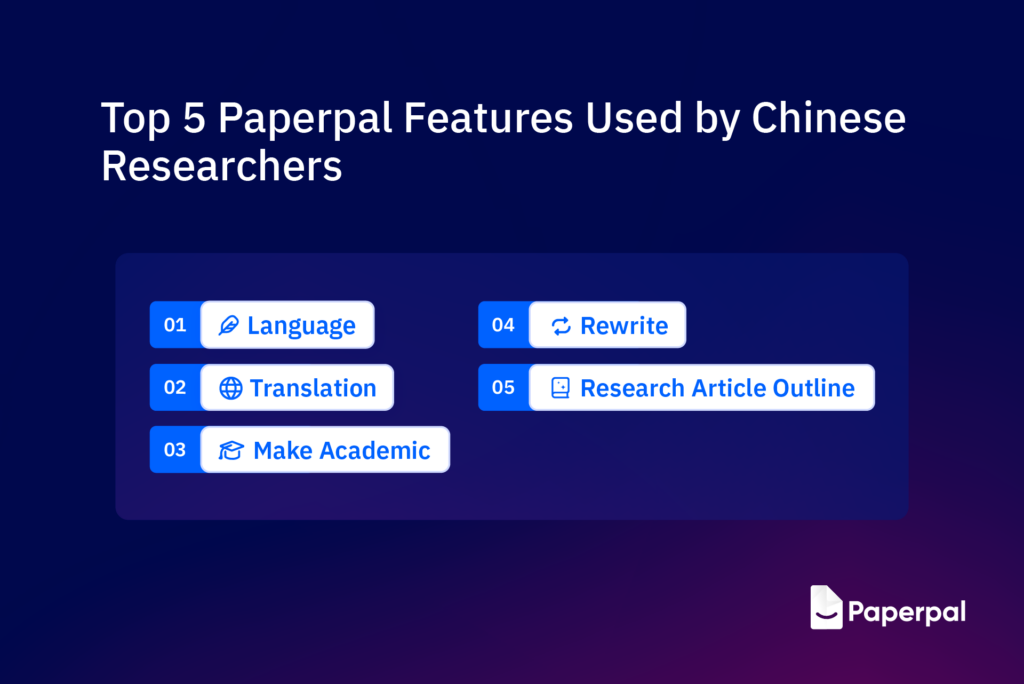
Paperpal Impact: Accelerating Academic Excellence and Boosting Productivity
Committed to providing researchers in China with a more streamlined academic writing experience, Paperpal has introduced a number of features and capabilities, which has transformed the path to academic success for Chinese researchers.
Growth in Number of Paperpal Users in China
Fueled by a user-friendly website that provides all relevant details in Chinese and localized payment options, Paperpal has seen a steady rise in the number of users from China from July 2022 to April 2024. Academics in China have created more than 29,000 documents on Paperpal, using it to translate and improve their content within a matter of minutes.
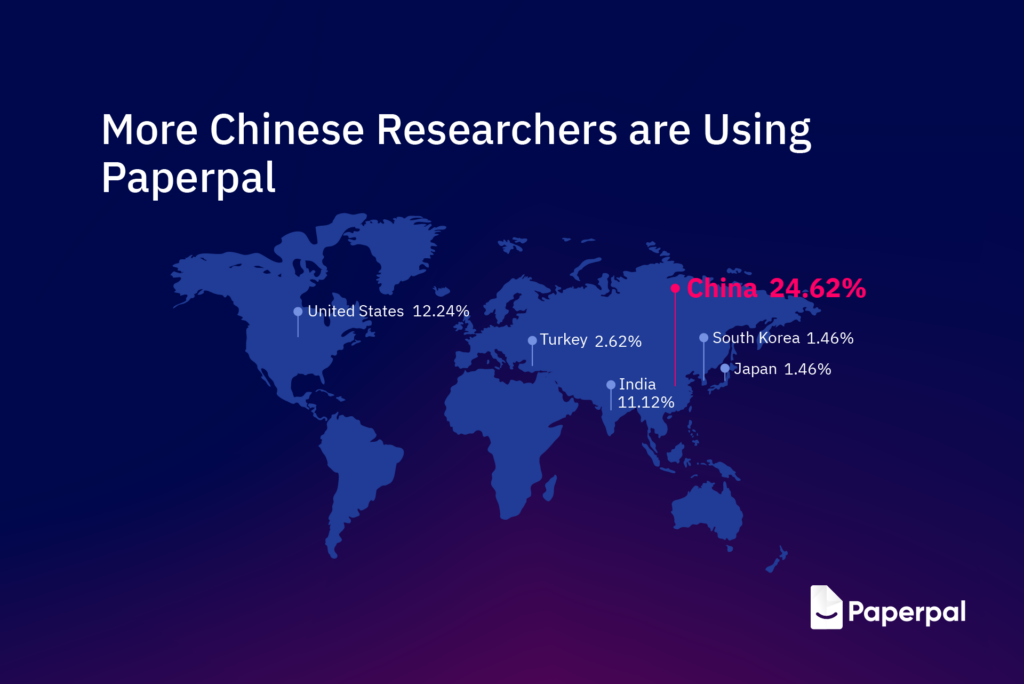
In addition, Chinese researchers also uploaded 26,527 manuscripts to Paperpal Preflight and benefitted from the customized submission readiness checks before submitting to reputed journals; this accounts for an impressive 24.6% of total uploads globally .
Hours of Time Saved to Increase Productivity
Academics in China have used Paperpal’s language correction to enhance over 43 million words. This could have effectively saved them more than one million minutes in proofreading time*, considering that experts can proofread approximately 2,500 words per hour.
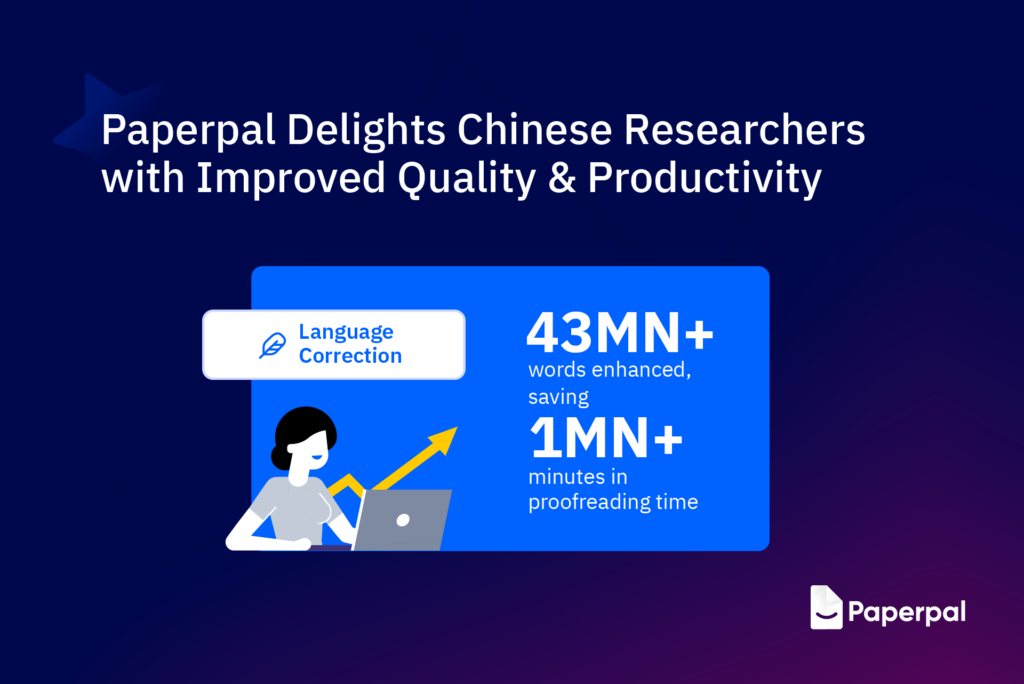
In addition to using Paperpal for improved language, Chinese researchers have also used it to instantly translate over 700,000 words. This could have saved them more than 67,000 hours of translation time*, considering experts can translate 2,000 words per day. No wonder that our Translation feature received a 100% positive rating for its fast, accurate, and clear translations, that is, ALL the users from China who rated this feature found it useful and gave it a thumbs up .
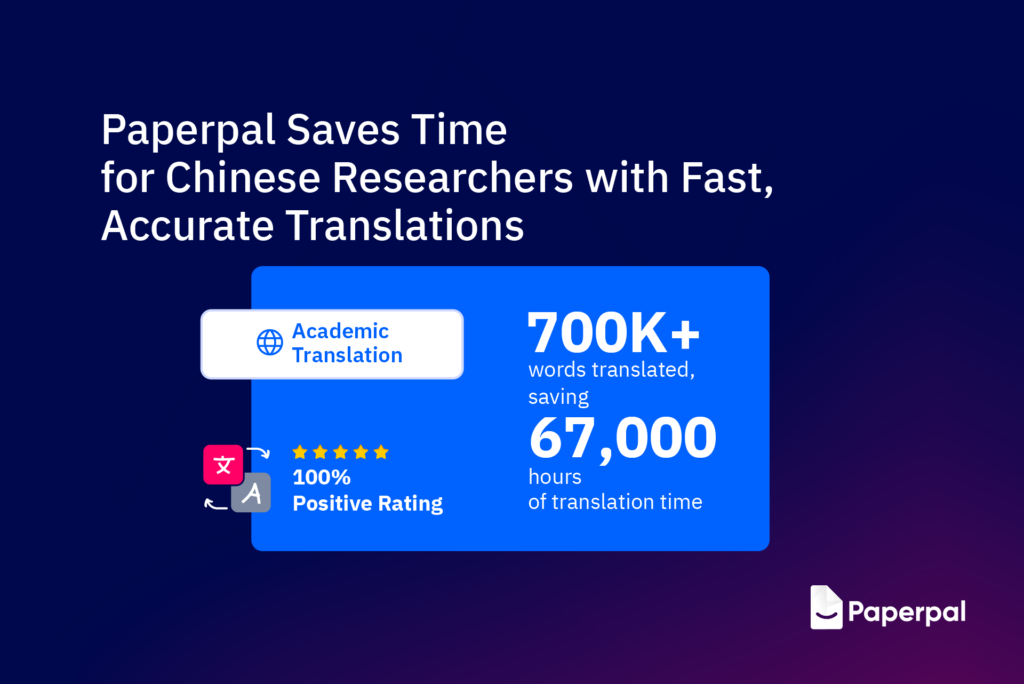
* These are only preliminary estimations based on the real-time processed volumes by Paperpal and the assumption of an average human proofreading/translation speed.
Adoption by Students at Top Institutions in China
Paperpal has seen high registrations and paid users among Chinese students from six top universities in China, as per the 2024 Times Higher Education China University Rankings. 3 These include the country’s most prominent institutions, such as:
- Tsinghua University
- Peking University
- Fudan University
- Zhejiang University
- University of Science and Technology China
- Nanjing University
Powering Research Excellence and Innovation
Apart from the top Chinese universities, Paperpal has also won the trust of research professionals from government organizations and leading institutions , including:
- 301 Hospital, the largest comprehensive military hospital in China
- Shengjjng Hospital of China
- Peking University Cancer Hospital and Institute
- Biotech Pharmaceutical Corporation Ltd., one of the top pharma companies in the country.
Paperpal is a trusted tool for researchers looking to publish in reputed scientific publishers. Chinese researchers, especially in the field of medicine, found Paperpal Preflight’s pre-submission checks especially useful to polish and submit their work to prestigious publishers , which include the following:
- Wolters Kluwer
- IOP Publishing
- Karger
- Wiley
- Taylor & Franics
- Emerald
- American Association for Cancer Research
- American Society of Clinical Oncology
- Cambridge University Press
- American Academy of Pediatrics
Winning the Trust of Chinese Researchers
As the number of Chinese students, researchers, and professionals using Paperpal increases, so does the trust that it receives. In fact, Paperpal has an outstanding Net Promotor Score of 75, especially for its AI translation and academic writing enhancements, which reflects high satisfaction levels and strong recommendations from Chinese academics .
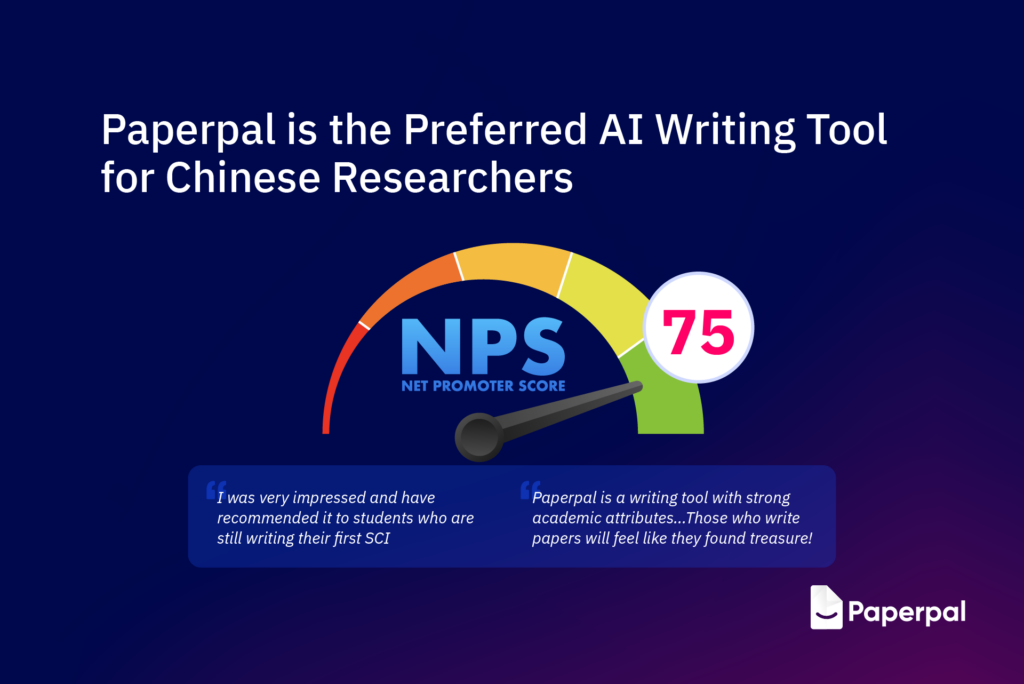
Paperpal is continually developing and adding new AI features to transform the academic writing journey, and we take pride in earning the love and trust of our users. Read what two of our users from China have to say about Paperpal’s ease of use, accuracy, and effectiveness:
Mr. Ye, Institute of Pharmaceutical Sciences, Peking Union Medical College, said, “The language editing feature works well, easily identifying grammatical problems and categorizing errors to give a basis for revision. The Rewrite feature has some weight reduction effect. I was very impressed and have recommended it to students who are still writing their first SCI.”
Liu Lu, PhD at Beijing University of Aeronautics and Astronautics, said, “Paperpal is a writing tool with strong academic attributes, translating and transcribing terms accurately, and then juxtaposing the language editing and synonym replacement features to bring up the depth and richness of the manuscript. Those who write papers will feel like they found treasure.”
Paperpal is transforming the tedious process of academic writing for Chinese students and researchers, empowering them to write better, faster, and in an ethical manner. By automating necessary checks and simplifying each step in the writing journey, Paperpal is helping to save researchers’ time while enabling them to write high-quality content and improve their productivity. This, in turn, helps researchers focus on their research, fueling academic excellence and moving them closer to publishing success. Paperpal also brings major benefits for universities, organizations, and publishers, helping them nurture an environment of excellence and growth that enables them to contribute to and further advance science.
It’s time to experience the advantage Paperpal brings to your academic writing. Start writing with Paperpal for free now or write to [email protected] for more details, and we’ll be happy to help!
References:
- Amano T, Ramírez-Castañeda V, Berdejo-Espinola V, Borokini I, Chowdhury S, Golivets M, et al. (2023) The manifold costs of being a non-native English speaker in science. PLoS Biol 21(7): e3002184. https://doi.org/10.1371/journal.pbio.3002184
- Liu, M. Problems and Solutions in Response to Postgraduates’ English Academic Writing – A Case of SWPU. Journal of Education and Educational Research . ISSN: 2957-9465 | Vol. 3, No. 3, 2023
- Best universities in China 2024, Times Higher Education University Rankings. Available online at https://www.timeshighereducation.com/student/best-universities/best-universities-china
Paperpal is a comprehensive AI writing toolkit that helps students and researchers achieve 2x the writing in half the time. It leverages 21+ years of STM experience and insights from millions of research articles to provide in-depth academic writing, language editing, and submission readiness support to help you write better, faster.
Get accurate academic translations, rewriting support, grammar checks, vocabulary suggestions, and generative AI assistance that delivers human precision at machine speed. Try for free or upgrade to Paperpal Prime starting at US$19 a month to access premium features, including consistency, plagiarism, and 30+ submission readiness checks to help you succeed.
Experience the future of academic writing – Sign up to Paperpal and start writing for free!
Related Reads:
- The Do’s & Don’ts of Using Generative AI Tools Ethically in Academia
- Addressing Your Queries on AI Ethics, Plagiarism, and AI Detection
- Paperpal Copilot is Live: Experience The Generative AI Tool Academics Can Trust
- Grammarly Review: Features, Pricing, and Free Alternatives
How to Write a Successful Book Chapter for an Academic Publication?
How paperpal’s research feature helps you develop and strengthen arguments in a pinch, you may also like, how paperpal’s research feature helps you develop and..., academic editing: how to self-edit academic text with..., 4 ways paperpal encourages responsible writing with ai, what are scholarly sources and where can you..., how to write a hypothesis types and examples , what is academic writing: tips for students, why traditional editorial process needs an upgrade, paperpal’s new ai research finder empowers authors to..., what is hedging in academic writing , how to use ai to enhance your college....

COMMENTS
Concept Paper vs. Research Proposal. Getting Started on Your Concept Paper. 1. Find a research topic you are interested in. Tips for finding your research topic. 2. Think of research questions that you want to answer in your project. 3. Formulate your research hypothesis.
Concept papers serve various fields, influencing the direction and potential of research in science, social sciences, technology, and more. They contribute to the formulation of groundbreaking studies and novel ideas that can impact societal, economic, and academic spheres. A concept paper serves several crucial purposes in various fields:
follow these steps: 1. Concept paper title. Every pa per must have a title and concept paper is not left out as one needs to have a title that. summarizes what the paper is about. The title should ...
to interest potential funders. to develop potential solutions or investigations into project ideas. to determine whether a project idea is fundable. to serve as the foundation of a full proposal. Funders that request concept papers often provide a template or format. If templates or formats are not provided, the following can serve as a useful ...
A concept paper is a short document written by a researcher before starting their research project, with the purpose of explaining what the study is about, why it is important and the methods that will be used. The concept paper will include your proposed research title, a brief introduction to the subject, the aim of the study, the research ...
1. To explore and expand an idea: Researchers can use concept papers to transform an incipient research idea into a focused, high-quality study proposal. The paper is also a means to obtain feedback that can be used to strengthen a detailed proposal at a later stage. 2. To draw the interest of funding agencies: Through an effective concept ...
A concept paper is a brief paper that outlines the important components of a research or project before it is carried out. Its purpose is to offer an overview. Entrepreneurs working on a business idea or product, as well as students and researchers, frequently write concept papers. Researchers may be required to prepare a concept paper when ...
Answer: A concept paper is a brief paper written by a university student around a research question before undertaking the research. The paper is about two or three pages long and provides key details about the research, such as the question, purpose, and methods. The paper allows the supervisor to gauge how well the student understands the ...
A concept paper might be the first thing a funding round requests to get an idea of what the project is all about. So make sure that it includes: Importance of the work being proposed. What the impact (not the same as ' impact factor ' - see later below) will be. How the outcomes of your project might meet or respond to the need.
An academic concept paper is a brief summary of a research project written by a university student who is about to conduct a certain research. It outlines the project in around 2-3 pages and its purpose is to give the department an idea of what the research is about, why the research is important, and how it will be carried out.
Abstract and Figures. This handout provides a detailed outline of how to write a conceptual academic paper for scholarly journal publication. It is based on my academic publishing experience and ...
Funders that request concept papers often provide a template or format. If templates or formats are not provided, the following can serve as a useful concept paper structure. THE FIVE ELEMENTS OF A CONCEPT PAPER 1. The first section, the Introduction, identifies how and where the applicant's mission and the funder's mission intersect or align.
the answer the questions in the order shown here. Some concept papers begin with an introductory statement which provides a general statement as to what you are trying to accomplish. (This statement is distinct from the more specific research or project objective, included later.) A common format includes these headings: Need,
The audience for the first iteration of your concept paper is your research colleagues, both ... For this version, jargon and academic/scientific terms are acceptable. Once you consider and incorporate feedback received from your research colleagues, the audience for the second iteration of your concept paper is potential funders. Do your
The Research Concept Paper is completed prior to the dissertation proposal and serves as a development tool and summary of the planned dissertation. The Concept paper is a brief document. Depending upon the requirements of the specific school or academic program, the Concept Paper may range from as few as 2-3 pages to as many as 10-20 pages.
Each of these examples is specific enough that we already have a sense of what the paper might discuss, but simple enough for most readers to quickly understand. Try one of the following to catch the reader's eye: • An eye-catching, startling fact or statistic. • An interesting or provocative question • A definition of a key term or concept
In academic concept papers, this period is usually pre-defined by the various university standards and one should have a look at their university standards on the research paper duration. The timeline must also include how the initial and final phases of the academic project is to be achieved.
How to Write a Concept Paper in academic writing, Research Proposals and Projects:Timestamps:00:00 Introduction00:27 What is a Concept Paper?01:43 Technic...
This document provides a concept paper for a research project that aims to analyze the current instructional consultation program and assess students' perceptions of it at a higher education institution. The project objectives are to improve student-teacher relationships and instructional consultation practices in line with institutional goals. Main activities will include distributing ...
How can academic scholars come up with great ideas, such that their research becomes even more important, relevant, and interesting? Based on ideation practices of sophisticated companies, this paper triggers academic researchers to self-reflect on: (1) the source used for ideation, (2) the scope applied to ideation, (3) the sharing of ideas during ideation, and (4) the selection of ideas.
A SAMPLE CONCEPT PAPER for an ACADEMIC RESEARCH Lorena A. Brillo, Ph.D. UP Open University December 1, 2017 Background Instructional consultation is a basic service to students, and it is an important tool in assessing the relevance of important basic institutional services. However, as perceived by students, a substantial gap still exists between the need for instructional consultation ...
The Online Writing Lab at Purdue University houses writing resources and instructional material, and we provide these as a free service of the Writing Lab at Purdue.
View Assessment - ACT 2.1 CONCEPT PAPER.docx from A EN ENGLISH LI at Malalag Cogon National High School. NAME:_ DATE:_ ACTIVITY 2.1 CONCEPT PAPER. Encircle the letter of your answer. 1. This is a
Choosing the right academic journal for your research paper is a critical step in the publication process. It can determine the reach and impact of your work, as well as align with your academic ...
A concept paper is a brief paper outlining the key aspects of a study before undertaking the study. It is meant to provide an idea of the study. ... Editage Insights offers a wealth of free academic research and publishing resources and is a one-stop guide for authors and others involved in scholarly publishing. Our original resources for ...
Struggling with academic editing? Discover how Paperpal, the AI academic writing and editing assistant, helps both native and non-native English speakers in perfecting research papers. From grammar and clarity to journal submission readiness and plagiarism checks, Paperpal offers support to enhance your academic writing with clarity, precision, and originality.
While sustainability has been a well-researched area in academic literature, the performance impact of its social dimensions remains largely unexplored, especially in the context of emerging economies. The aim of this research paper is to test and validate the dimensions of supply chain social sustainability (SCSS) that firms should focus on and to examine the relationships between these ...
Key steps to follow when writing an academic book chapter. Integrating the following steps as you plan to write an academic book chapter can help you achieve excellent results. Information collection . It is important that sufficient research is carried out and the author has a thorough understanding of the available literature in the field.
Paperpal, by Editage, has emerged as a trusted AI academic writing assistant for more than 800,000 authors worldwide, supporting them from the ideation stage all the way to submission readiness for journals.It blends over 21 years of STM experience with cutting-edge AI technology to provide comprehensive writing, language editing, and submission readiness support that boosts their chances of ...
A clear distinction between the two is merely their types. A concept paper is about a topic of your interest which you would like to explore further while carrying out research, while a research paper is the output of your work. It is more than the summation of your sources, collage of information about a topic, and more of a literature review of that subject.